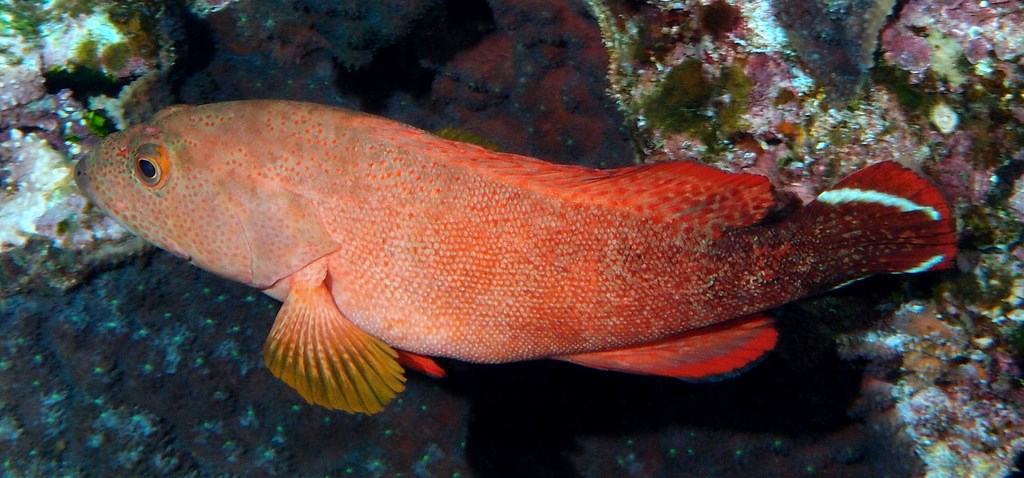CEPHALOPHOLIS URODETA - (FORSTER, 1801)
Actinopterygii (Gigaclass) > Actinopteri (Class) > Teleostei (Subclass) > Perciformes (Order) > Percoidei (Suborder) > Epinephelidae (Family) > Cephalopholis (Genus)
Loche urodèle, Vieille aile noire, Mérou tacheté à queue noire, Vieille chinois foncée, Vieille coq, Banded-tail coral-cod, Blackfin cod, Black-finange rock cod, Brown-finned rock-cod, Chevron rock-cod, Darkfin hind, Duskyfin hind, Duskyfin rockcod, Flag-tail rock cod, Flag-tailed grouper, Flag-tailed rockcod, Flagtail cod, Flagtail grouper, Donkervin-klipkabeljou, Zackenbarsch, Kurobivebata, Garoupa barbatana negra, Cherna alinegra, Nijihata, ニジハタ, 尾紋九刺鮨,
Synonymes
Anthias teatae (Curtiss, 1938)
Cephalopholis urodela (Valenciennes, 1828)
Cephalopholis urodelus (Valenciennes, 1828)
Cephalopholis urodelus (Forster, 1801)
Epinephelus erythraeus (Valenciennes, 1830)
Epinephelus playfairi (Bleeker, 1879)
Epinephelus playfayri (Bleeker, 1879)
Epinephelus urodelus (Valenciennes, 1828)
Perca urodeta (Forster, 1844)
Perca urodeta (Forster, 1801)
Percam urodetam (Forster, 1801)
Serranus erythraeus (Valenciennes, 1830)
Serranus mars (De Vis, 1884)
Serranus urodelus (Valenciennes, 1828)
-----------------------
Description
Dorsal spines (total): 9; Dorsal soft rays (total): 14-16; Anal spines: 3; Anal soft rays: 8-9 (usually: 9); Pectoral fin rays: 17-19; Lateral line scales: 54-68; Longitudinal scale series: 88-108. Fin with a pair of diagonal white bands; Body scales ctenoid; Greatest depth of body: 2.75-3.1 in SL; Rounded caudal fin; Pelvic fins: 1.8-2.2 in head length; Head length: 2.4-2.7 in SL; Convex interorbital area; Rounded preopercle, finely serrate, fleshy lower edge; Subopercle and interopercle usually smooth; Maxilla reaching well past eye; Pectoral fins distinctly longer than pelvic fins; Caudal fin rounded; Snout and maxilla with minute cycloid scales. Max. length: 28.0 cm TL. Depth range: 1 - 60 m, usually: 3 - 15 m.
Loche urodèle, Vieille aile noire, Mérou tacheté à queue noire, Vieille chinois foncée, Vieille coq, Banded-tail coral-cod, Blackfin cod, Black-finange rock cod, Brown-finned rock-cod, Chevron rock-cod, Darkfin hind, Duskyfin hind, Duskyfin rockcod, Flag-tail rock cod, Flag-tailed grouper, Flag-tailed rockcod, Flagtail cod, Flagtail grouper, Donkervin-klipkabeljou, Zackenbarsch, Kurobivebata, Garoupa barbatana negra, Cherna alinegra, Nijihata, ニジハタ, 尾紋九刺鮨,
Synonymes
Anthias teatae (Curtiss, 1938)
Cephalopholis urodela (Valenciennes, 1828)
Cephalopholis urodelus (Valenciennes, 1828)
Cephalopholis urodelus (Forster, 1801)
Epinephelus erythraeus (Valenciennes, 1830)
Epinephelus playfairi (Bleeker, 1879)
Epinephelus playfayri (Bleeker, 1879)
Epinephelus urodelus (Valenciennes, 1828)
Perca urodeta (Forster, 1844)
Perca urodeta (Forster, 1801)
Percam urodetam (Forster, 1801)
Serranus erythraeus (Valenciennes, 1830)
Serranus mars (De Vis, 1884)
Serranus urodelus (Valenciennes, 1828)
-----------------------
Description
Dorsal spines (total): 9; Dorsal soft rays (total): 14-16; Anal spines: 3; Anal soft rays: 8-9 (usually: 9); Pectoral fin rays: 17-19; Lateral line scales: 54-68; Longitudinal scale series: 88-108. Fin with a pair of diagonal white bands; Body scales ctenoid; Greatest depth of body: 2.75-3.1 in SL; Rounded caudal fin; Pelvic fins: 1.8-2.2 in head length; Head length: 2.4-2.7 in SL; Convex interorbital area; Rounded preopercle, finely serrate, fleshy lower edge; Subopercle and interopercle usually smooth; Maxilla reaching well past eye; Pectoral fins distinctly longer than pelvic fins; Caudal fin rounded; Snout and maxilla with minute cycloid scales. Max. length: 28.0 cm TL. Depth range: 1 - 60 m, usually: 3 - 15 m.
Color
Reddish-brown to pale greyish-brown body becoming darker towards the rear, with distinctive whitish to pale blue oblique stripes across upper and lower lobes of the tail, often six faint bars along the side that divide ventrally, small orange-red spots on the head and nape, and a pair of dark spots on the front of the lower lip. It also has yellowish pectoral fins and usually a large reddish to brownish spot on the outer margin of the gill cover.
Etymology
Cephalopholis: from Greek, kephale = head + from Greek, pholis = scale. Referring to completely scaled head of Cephalopholis argus.
Etymology
Cephalopholis: from Greek, kephale = head + from Greek, pholis = scale. Referring to completely scaled head of Cephalopholis argus.
urodeta: etymology not explained.
Original description: Perca urodeta Forster, 1801 - Type locality: St. Christina Island, Waitaho (Vaitahu, Tahuata Island, Marquesas Islands, French Polynesia, South Pacific).
Distribution
Eastern Indian Ocean, western Pacific: Christmas Island and Indonesia east to Wake Atoll, Line Islands and Pitcairn Group, south to Western Australia at 32°01'S, Queensland (Australia) at 18°16'S, New Caledonia, Tonga and Rapa.
Biology
Inhabits clear, shallow waters of outer reef areas. Also found in lagoons, back-reef areas, and on the reef-top. Prefers healthy coral reef in shallow area therefore is greatly affected by reef degredation. Feeds on small fishes (68%) and crustaceans. Solitary. Commercial and aquarium fish. Cephalopholis nigripinnis can hybridizes with Cephalopholis urodeta at Christmas Island.
Distribution
Eastern Indian Ocean, western Pacific: Christmas Island and Indonesia east to Wake Atoll, Line Islands and Pitcairn Group, south to Western Australia at 32°01'S, Queensland (Australia) at 18°16'S, New Caledonia, Tonga and Rapa.
Biology
Inhabits clear, shallow waters of outer reef areas. Also found in lagoons, back-reef areas, and on the reef-top. Prefers healthy coral reef in shallow area therefore is greatly affected by reef degredation. Feeds on small fishes (68%) and crustaceans. Solitary. Commercial and aquarium fish. Cephalopholis nigripinnis can hybridizes with Cephalopholis urodeta at Christmas Island.
Similar species
Cephalopholis nigripinnis (Valenciennes, 1828) - Reported from Indian Ocean: South Africa, East Africa, Seychelles, Madagascar and Mascarenes east to Andaman Sea and Christmas Island (eastern Indian Ocean). Reddish body becoming dark brown posteriorly, with a prominent brown spot on the edge of the gill cover, and usually a broad dark margin on the pectoral fin.
Last update: 22, August 2022
